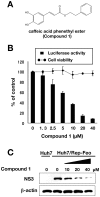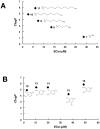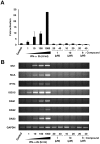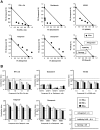Inhibitory effects of caffeic acid phenethyl ester derivatives on replication of hepatitis C virus
- PMID: 24358168
- PMCID: PMC3866116
- DOI: 10.1371/journal.pone.0082299
Inhibitory effects of caffeic acid phenethyl ester derivatives on replication of hepatitis C virus
Abstract
Caffeic acid phenethyl ester (CAPE) has been reported as a multifunctional compound. In this report, we tested the effect of CAPE and its derivatives on hepatitis C virus (HCV) replication in order to develop an effective anti-HCV compound. CAPE and CAPE derivatives exhibited anti-HCV activity against an HCV replicon cell line of genotype 1b with EC50 values in a range from 1.0 to 109.6 µM. Analyses of chemical structure and antiviral activity suggested that the length of the n-alkyl side chain and catechol moiety are responsible for the anti-HCV activity of these compounds. Caffeic acid n-octyl ester exhibited the highest anti-HCV activity among the tested derivatives with an EC50 value of 1.0 µM and an SI value of 63.1 by using the replicon cell line derived from genotype 1b strain Con1. Treatment with caffeic acid n-octyl ester inhibited HCV replication of genotype 2a at a similar level to that of genotype 1b irrespectively of interferon signaling. Caffeic acid n-octyl ester could synergistically enhance the anti-HCV activities of interferon-alpha 2b, daclatasvir, and VX-222, but neither telaprevir nor danoprevir. These results suggest that caffeic acid n-octyl ester is a potential candidate for novel anti-HCV chemotherapy drugs.
Conflict of interest statement
Figures





Similar articles
-
Caffeic acid phenethyl ester activation of Nrf2 pathway is enhanced under oxidative state: structural analysis and potential as a pathologically targeted therapeutic agent in treatment of colonic inflammation.Free Radic Biol Med. 2013 Dec;65:552-562. doi: 10.1016/j.freeradbiomed.2013.07.015. Epub 2013 Jul 26. Free Radic Biol Med. 2013. PMID: 23892357
-
Inhibitory Effects of Caffeic Acid, a Coffee-Related Organic Acid, on the Propagation of Hepatitis C Virus.Jpn J Infect Dis. 2015;68(4):268-75. doi: 10.7883/yoken.JJID.2014.309. Epub 2015 Jan 20. Jpn J Infect Dis. 2015. PMID: 25672401
-
Structure-based identification of herbacetin and caffeic acid phenethyl ester as inhibitors of S-adenosylmethionine-dependent viral methyltransferase.FEBS Lett. 2025 Jun;599(11):1531-1555. doi: 10.1002/1873-3468.70054. Epub 2025 May 12. FEBS Lett. 2025. PMID: 40353321
-
The Pluripotent Activities of Caffeic Acid Phenethyl Ester.Molecules. 2021 Mar 2;26(5):1335. doi: 10.3390/molecules26051335. Molecules. 2021. PMID: 33801469 Free PMC article. Review.
-
The potential usage of caffeic acid phenethyl ester (CAPE) against chemotherapy-induced and radiotherapy-induced toxicity.Cell Biochem Funct. 2012 Jul;30(5):438-43. doi: 10.1002/cbf.2817. Epub 2012 Mar 20. Cell Biochem Funct. 2012. PMID: 22431158 Review.
Cited by
-
Propolis Extract and Its Bioactive Compounds-From Traditional to Modern Extraction Technologies.Molecules. 2021 May 14;26(10):2930. doi: 10.3390/molecules26102930. Molecules. 2021. PMID: 34069165 Free PMC article. Review.
-
Potential role of medicinal plants and their constituents in the mitigation of SARS-CoV-2: identifying related therapeutic targets using network pharmacology and molecular docking analyses.RSC Adv. 2020 Jul 27;10(47):27961-27983. doi: 10.1039/d0ra05126h. eCollection 2020 Jul 27. RSC Adv. 2020. PMID: 35519104 Free PMC article.
-
Host-Guest Interactions of Caffeic Acid Phenethyl Ester with β-Cyclodextrins: Preparation, Characterization, and In Vitro Antioxidant and Antibacterial Activity.ACS Omega. 2024 Jan 9;9(3):3625-3634. doi: 10.1021/acsomega.3c07643. eCollection 2024 Jan 23. ACS Omega. 2024. PMID: 38284065 Free PMC article.
-
Compounds with Antiviral, Anti-Inflammatory and Anticancer Activity Identified in Wine from Hungary's Tokaj Region via High Resolution Mass Spectrometry and Bioinformatics Analyses.Int J Mol Sci. 2020 Dec 15;21(24):9547. doi: 10.3390/ijms21249547. Int J Mol Sci. 2020. PMID: 33334025 Free PMC article.
-
Lessons from Exploring Chemical Space and Chemical Diversity of Propolis Components.Int J Mol Sci. 2020 Jul 15;21(14):4988. doi: 10.3390/ijms21144988. Int J Mol Sci. 2020. PMID: 32679731 Free PMC article. Review.
References
-
- Baldo V, Baldovin T, Trivello R, Floreani A (2008) Epidemiology of HCV infection. Curr Pharm Des 14: 1646–1654. - PubMed
-
- Lohmann V, Korner F, Koch J, Herian U, Theilmann L, et al. (1999) Replication of subgenomic hepatitis C virus RNAs in a hepatoma cell line. Science 285: 110–113. - PubMed
-
- Hofmann WP, Zeuzem S (2011) A new standard of care for the treatment of chronic HCV infection. Nat Rev Gastroenterol Hepatol 8: 257–264. - PubMed
Publication types
MeSH terms
Substances
LinkOut - more resources
Full Text Sources
Other Literature Sources

